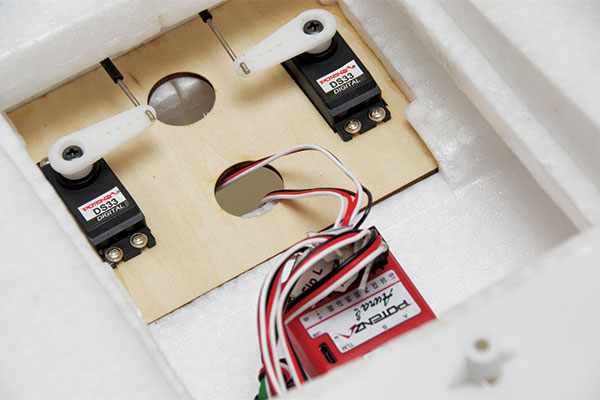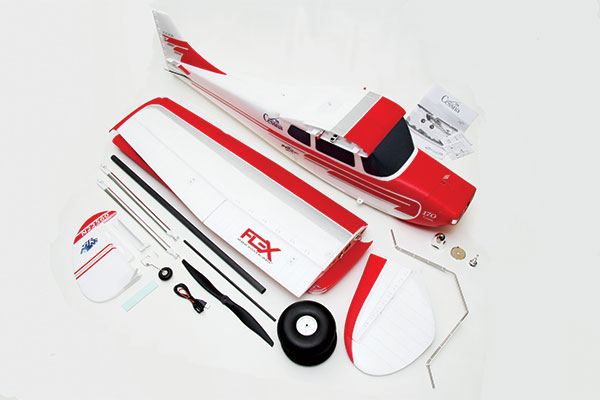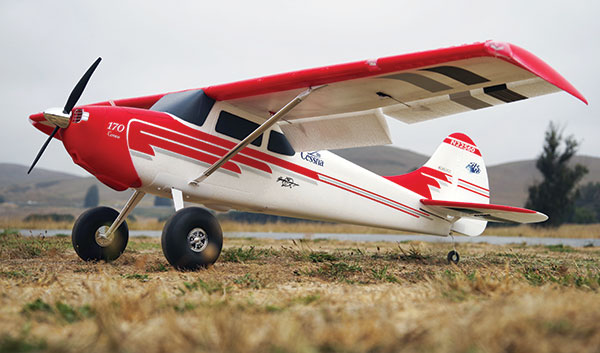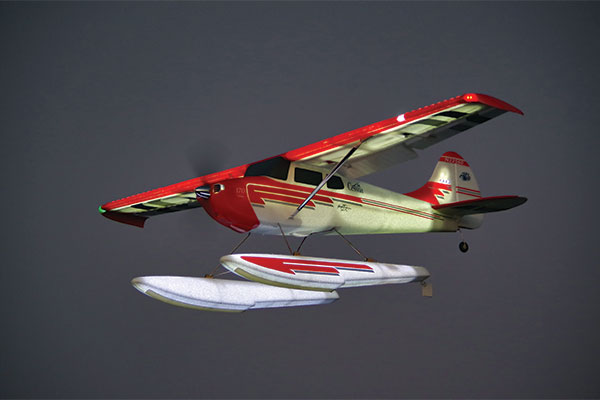Flex Innovations Premier Aircraft Cessna 170 Night PNP

Written by Jon Barnes A general aviation icon with aerobatic chops Exclusive product review Photos by the author As seen in the December 2016 issue of Model Aviation.
Bonus video
Specifications
Model type: Giant Scale sport model Skill level: Intermediate Wingspan: 86.7 inches Wing area: 1,094 square inches Length: 60.1 inches Weight: 8.6 to 9.6 pounds Power system: Potenza 60L 540 Kv brushless motor (included) Radio: Minimum six-channel radio and receiver Construction: EPO foam Street price: $499.99; night: $559.99; float set: $94.99Test-model details
Motor used: Potenza 60L 540 Kv brushless outrunner Speed controller: Hobbywing 80-amp with external SBEC and EC5 connector Battery: Turnigy heavy-duty 60C 6S 5,000 mAh LiPo Propeller: Flex Innovations SR 16 x 6 Radio system: Spektrum DX9 2.4 GHz DSMX Ready-to-fly weight: 8.5 to 10 pounds Flight duration: 6 to 9 minutesPluses
• An extremely versatile model that can be flown day or night from land, water, or snow. • The included brushless electric power system allows modelers to use a variety of cell count and capacity batteries. • The included Aura 8 comes preprogrammed with three distinct flight modes and can be modified using the free Aura 8 software. • Officially licensed by Cessna, this Giant Scale foam model capably captures the elegant aesthetics of the classic general aviation Cessna 170 tail-dragger. • The LED lighting system illuminates the entire airframe and eliminates orientation issues, making it possible to fly the model in complete darkness.Minuses
• The plastic landing gear fairings easily pop loose from the main gear wire struts when landing. • Wing retention fasteners thread into plastic receivers instead of metal ones, which increases the chances of them becoming fatigued with repeated use.Bonus video
Product review
The popularity of foam composition models throughout the last decade is undeniable. These quick-assembling, durable aircraft typically feature wingspans of between 900mm and 1,700mm. However, Giant Scale foam models have been a rarer breed. Although the moniker “giant,” when used in the context of RC models, can simply refer to a model that is larger than whatever size model a pilot typically flies, the official definition of a Giant Scale model is a monoplane with a wingspan of at least 80 inches or a biplane possessing at least a 60-inch wingspan. In this context, the number of authentic Giant Scale foam models made available to modelers over the course of the foam revolution has been limited. Industry newcomer Flex Innovations, founded by 3-D pilot Quique Somenzini and David Ribbe, decided to go big with the release of the company’s Premier Aircraft Cessna 170. Spanning 86 inches, this EPO foam composition model is uniquely labeled as a “Super Plug and Play” (PNP) kit. The impressive list of preinstalled electronics in this officially licensed Cessna 170 kit justify the label. Headlining the list is an Aura 8 Advanced Flight Control System (AFCS) that is preprogrammed with three model-specific flight modes. A high performance 3-D mode is also available for download from Flex Innovation’s website and can easily be loaded into the Aura AFCS using the included USB cable. The included power system uses a .60-size Potenza brushless outrunner, a Hobbywing 80-amp speed controller, and a stand-alone 8-amp SBEC. This brushless power system can be powered by a four-, five-, or six-cell LiPo battery in capacities ranging from 3,300 to 5,000 mAh. Other notable factory-installed electronics include Potenza 33-gram digital metal gear servos. These robust, high-torque servos are used on all control surfaces except for the flaps, which are powered by Potenza 19-gram metal gear digital servos.
The Potenza 33-gram digital metal gear servos are used on all of the flight control surfaces except for the flaps. They feature 60 ounces of torque at 5 volts.
Large-diameter Tundra tires hint at this general aviation aircraft’s backwoods pedigree, with optional floats and snow skis making this large Cessna 170 a model for all seasons and surfaces. With a 3S 1,300 to 2,200 mAh battery pack connected to the high-power LED lighting system, a pilot can keep the party going well after the sun sets! Other options for this versatile model include a set of fixed leading edge (LE) slats and a 3-D printer-generated Möbius camera mount.
Construction
With the airframe components unpacked from the jumbo-size box, this vintage Cessna 170 model merits a quick walkaround. The foam fuselage is smartly finished in an authentic red and white Cessna 170 scheme. A pair of retro-looking, chrome-finished cowl grilles allows cooling air to enter the fuselage and is augmented by a set of scooped, plastic exhaust ducts located on the fuselage’s underside. The result is a guaranteed supply of vital cooling airflow through the fuselage to help keep the power system components from overheating in flight. This unique airframe has rows of vortex generators almost everywhere you look! They are not just limited to the LEs of the wing halves; they are also molded into the vertical and horizontal stabilizers. The foam cowl is removable, thanks to cleverly concealed fasteners that can be accessed through the cowl grilles with a long-shaft screwdriver. With the cockpit hatch removed, pilots have easy access to the Cessna’s huge interior. The battery tray is long enough that whatever battery packs a pilot chooses to use can be easily positioned to obtain the optimal center of gravity. Another large, removable hatch, situated directly atop the Aura AFCS control system, allows ample access to the rear innards of the fuselage and the rudder and elevator servos. Pilots will like that Flex Innovations uses CA hinges on all of the control surfaces. Some pilots, however, might not be comfortable with the plastic clevises on the pushrods that connect to the flight control surfaces. Flex Innovations includes a 28-page, black and white, photo-illustrated assembly manual with this model. It is also available online in a digital format. Single-sheet instructions are also included for the Hobbywing 80-amp ESC and 8-amp SBEC.
Pilots can expect to spend a mere hour or two assembling the large foam pieces of this Giant Scale PNP kit.
In a departure from the current trend to include several languages in the assembly manual, the 170’s is only written in English. The assembly manual is supplemented by a dynamic and sure to be ever-evolving wiki page, located on the Flex Innovations website and dedicated specifically to this model. The assembly manual contains a wealth of useful information, including a transmitter setup guide, a matrix of the rates and exponentials preprogrammed into the Aura AFCS, and information that will help pilots connect their receiver of choice to the Aura AFCS. The Aura can auto-detect and connect to almost any data-linked receiver currently on the market, including Futaba S.Bus, Graupner HOTT, Jeti UDI, JR XBus, and Spektrum SRXL. Going this route makes for a clutter-free receiver wiring setup. Another clean and easy option is to plug a pair of Spektrum DSMX remotes directly into the Aura AFCS. Pilots can also use a more-traditional pulse-width modulation receiver, but doing so will require sourcing several male-to-male servo leads and other miscellaneous servo leads in order to make the necessary connections between the Aura and receiver. The Flex Innovations website offers the required cabling, as well as a full selection of spare parts for this model, should a pilot need to replace airframe components or electronics. Assembling the big 170 can be done quickly. Flex Innovations even includes a couple of hex wrenches in the box. The rudder is the only airframe component that requires adhesive. It keys into the aft edge of the vertical stabilizer using a pair of rectangular indexing blocks that are molded into the trailing edge of the vertical stabilizer. These two foam components mesh tightly. A little medium CA spread judiciously across the mating surfaces permanently locks them together. Flex Innovations suggests that modelers avoid using accelerator when employing cyanoacrylate adhesives on this model because it can slightly compromise the relative strength of the glue joint. Items that must be mechanically assembled include the tail wheel assembly, main landing gear, and propeller/spinner assembly. The wing halves share a large-diameter carbon-fiber spar and feature two indexing tabs that align with receivers on the fuselage. Multiple connections must be made when mounting the wings to the fuselage. The flap and aileron servo leads are taped into position on plastic frames. It is difficult to see the polarity of these leads because of the way they are mounted. Pilots might wish to mark the polarity of these connections on the fuselage for quick reference when assembling the wings to the fuselage. The LED-equipped night version of this model uses JST connectors for all of the lighting system wiring. The wing-retention fastener receivers on the Cessna are plastic. Repeatedly threading the metal hex-head, machine-thread screws into and out of them could eventually lead to them losing some of their holding power. Pilots might be able to carefully position and glue metal nuts into place within these plastic receivers for a more secure metal-to-metal joint.
Flying
Although it does fit in a full-size pickup bed when fully assembled, the Cessna 170’s goliath-like dimensions will preclude most modelers from transporting it to the field fully assembled. Attaching and removing the two wing halves can be accomplished by most pilots in 10 minutes or less. There is an absolutely amazing amount of space inside the Cessna’s cavernous fuselage. Pilots can enjoy nearly unlimited space in which to try practically any four-, five-, or six-cell battery pack that they have on hand. The large opening created by removing the cockpit hatch makes it easy to slip even large batteries in place. Three beefy hook-and-loop straps are preinstalled and are used to belt the flight battery in place on the plywood battery tray.
This model nicely captures the vintage lines of the classic general aviation Cessna 170 tail-dragger and features a scalelike red and white paint scheme.
With a 4S 5,000 mAh LiPo pack, the Cessna’s power system shows roughly 550 watts worth of performance. Pilots who like things slow and easy, or who prefer to fly their models in a sedate and scalelike fashion, will want to stick with this cell count. Although five-cell battery packs are typically less readily available, flights using a 35C 5S 4,400 mAh LiPo battery pushed the watts up to 1,075. Although the extra cell substantially enlivens the big Cessna, going with a 50C 6S 5,000 mAh battery pack really lets this giant get its roar on! With the 6S battery pack belted in place, the Potenza outrunner and SR 16 x 6 propeller create more than 1.5 kilowatts of fire-breathing power! Fast-paced, extreme aerobatics and many 3-D maneuvers are well within this giant’s repertoire when flying on a 6S pack. All three of the flight modes that are preprogrammed into the Aura include both rudder-to-aileron and rudder-to-elevator mixes. These mixes allow the big Cessna to perform knife-edge flight like a purebred aerobat, with no tendency to pull or push out of the maneuver. The abundance of vortex generators peppered across the airframe help keep the model extremely stable when transitioning into slower-speed, high-alpha orientations. This behemoth can even hang on the propeller in a sustained hover, with plenty of oomph left to punch out vertically at the end of the maneuver! Roll rates on Flight Mode 3 are quite fast for a plus-size model. For pilots who want even more snap in their aerobatics, an optional set of advanced 3-D flight modes is available online from Flex Innovations, and can be downloaded into the Aura AFCS. Installing longer flap pushrods (included in the box) allows the flaps to deflect equally in both the up and down direction in these optional flight modes, treating pilots to several more-advanced mixes. These include mixing the flaps in with the ailerons for increased slow-speed roll authority. The variety of battery cell counts and capacities of packs that can be used in this model, combined with the three flight modes preprogrammed into the Aura AFCS, truly allows pilots to set up the model for their own preferences. Running the Aura AFCS on the general rates mode disables its gyro stabilization system, while the other two modes allow it to compensate for the effects of wind and turbulence. Most pilots will enjoy the way in which the Aura automatically stabilizes the Cessna. Flex Innovations has already done the homework to find the optimal gains. No signs of oscillation were noted throughout flight testing, even when flying a six-cell battery pack at wide-open throttle. No matter which pack a pilot goes with, the wing loading of this big Cessna is incredibly light. Although the wing loading works out to roughly 20 to 21 ounces per square foot, a much more accurate portrayal of this model’s loading and performance is its wing cube loading number of 7.4. This puts it in a category with many trainers. The Cessna’s large barn-door-style flaps and Tundra tires endow it with insane short takeoff and landing capabilities. With the flaps fully deployed, the model can leap into the air in as little as 10 feet and from almost any surface, no matter how uneven. Pilots unaccustomed to the effects of large, aggressively deployed flaps on an airframe should be prepared to push the nose down. Slowing the flap movement can help mitigate this ballooning action. The plastic main gear strut fairings demonstrated a tendency to pop loose whenever the landing gear was subjected to the excess flex inherent to a less-than-soft landing. Pilots can more securely anchor them in place using small tie-wraps or a little silicon adhesive. Swapping the Tundra gear for the optional floats can be done in 10 to 15 minutes and includes feeding the water rudder lead and night-light power leads into the fuselage. The large access hatches make it easy to route the cables to their destinations within the fuselage.

The LED lighting system used on the Night version of the Flex Cessna and optional internally lit floats allow pilots to hit the water after dark, when the wind and waves are usually calm.
Long, white, plastic strips line the bottom of the floats and help protect them from damage. The Cessna’s maiden flights off of water took place on a day with wind at 10 to 12 mph. The big 170 shook off the moderate chop, racing across the water’s surface like a big dog shaking water off of its back! Thanks to the Aura AFCS’s stabilizing influences, departures and touch-and-gos with half flaps in less-than-calm conditions were incredibly precise and controlled. The real party starts when the sun sets. With a 3S 2,200 mAh LiPo pack strapped to the most-forward hook-and-loop strap and connected to the night lights, this model beams as brightly as a midway attraction on a moonless night. The floats generate so much light that they even permit a pilot to see the surface of the water as the model approaches. The lights do such an effective job of illuminating the entire airframe that pilots should have absolutely no fear of losing orientation when flying in the dark.










3 comments
hardware
Poor Quality Control
No Quality Control
Add new comment